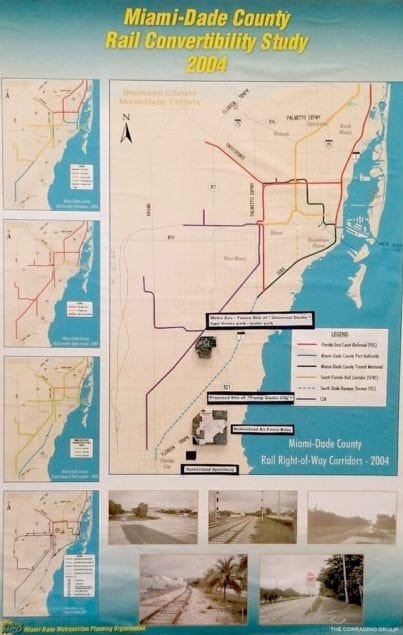
When governments get bogged down in bickering and negativism, it is easy for sitting politicians to sit some more.
But that is not my style; and that is not what the people deserve.
Thankfully, there are other politicians who are willing to buck the trend, swim upstream, shed conventional wisdom and push against “can’t do” leaders who will not lead.
Churchill once said, of an opponent, that “he occasionally stumbled into the truth, but he got up and walked away as if nothing had happened.”
Today, I come to praise Joe Martinez. Let me explain.
THE SMART PLAN AT A STANDSTILL
For various and sundry reasons – most notably that Mayor Gimenez changed his mind about the technical and financial feasibility of the SMART plan – we are stuck in the muddy field of discord, with many commissioners wanting to implement the original rail plan and others abiding by the mayor’s view that trains are a “19th century technology” and, besides, there is no money, honey.
Enter Commissioner Joe Martinez, whose district is one of the least served by mass transit – or even by passable highways.
I have always liked the feistiness of the man. When I was elected to the commission in 2011, he was the commission chairman. He coached me, in Sunshine meetings and other public forums, on the viability of what was called a “rail convertibility plan.”

The idea was simple: As railroad companies (FEC and CSX) abandon their right-of-way corridors in our increasingly car and truck reliant metropolis, why not turn them into corridors for passenger trains.
The Florida East Coast Railway (FEC) did exactly that, at its own cost, and we now have a very viable train that services three counties (Virgin Trains USA) and a commuter train (Tri-Rail Coastal Link) using the same, newly improved tracks.
Move forward to our recent Sunshine Meeting.
MONDAY, JUNE 10TH, SUNSHINE MEETING (SUAREZ/MARTINEZ)
Faced with delays on his preferred solution for Southwest Dade (the so-called Turnpike Extension concocted by the beleaguered MDX), Com. Martinez immediately agreed to a Sunshine Meeting to consider alternatives.
Those who were present on Monday will always marvel at the speedy and collaborative way in which the two of us met, with the poor clerk of the board doing her best to take down our staccato back-and-forth discussion.
One thing about Martinez you can count on: He’s not shy and he doesn’t mince words.
We both faced facts: (1) the SMART plan, calling for $3.6 billion of new rail corridors, is stalled; and (2) trolleys operated by various cities, charging absolutely no fare, are one hell of a partial, interim solution that in some cases will become permanent. After all, they traverse the metropolitan grid in a vertical and horizontal direction, feeding what we hope will eventually be, at least six major rail corridors.
THE KENDALL TROLLEY
In the span of about 6.5 minutes, Martinez gave his seal of approval to the imminent Kendall trolley pilot plan, consisting of three trolleys operating on Kendall Drive from Dadeland South to Baptist Hospital, at SW 92nd Avenue. With a fifteen-minute headway, the new routes will provide a connection to and from both North and South Dadeland Metrorail stations. This trolley route serves a population of 11,000 and more than 22,000 jobs. We soon moved to:
THE FIU-MIAMI CITY LIMITS CIRCULATOR
Seizing the initiative, and mindful that the county somehow distinguishes unincorporated from incorporated areas in its funding allocations, Com Martinez quickly addressed my proposal of a trolley connector along the Flagler axis, from where the city service ends (roughly 70th avenue) to FIU (107th Ave). The solution he offered was to call the vehicles “circulators.”
Fine with me.
The county bureaucrats immediately raised the issue of current demand, suggesting that existing bus service was sufficient for the demand. That is, in one word, laughable. Free trolleys are gobbling up passengers so fast in Miami, Miami Beach, Coral Gables, Doral, Miami Gardens and elsewhere that the total ridership (14 million passengers/year) will soon eclipse the ridership of the entire Metrorail system.
A system of free trolleys/circulators connecting FIU to downtown Miami (and the free Metromover) would inevitably draw enormous ridership. This entire route would connect five districts, but the impact would be county-wide. Com. Javier Souto has been supportive of circulators and has implemented the Westchester circulator at the minimal cost of just 25 cents; the smaller vehicle is designed to look more attractive than the ugly buses that have become so famous for their low ridership.
BACK TO THE CSX LINE
Before we ended our whirlwind Sunshine session – all thirty minutes of it – we quickly discussed the possible purchase of the CSX line, which, as Com Martinez stated, “goes everywhere” in the southwest area of the county. The Director of the Department of Transportation and Public Works, Alice Bravo, reported to us that negotiations were at a standstill with CSX for what could be a $300 million price tag. It is evident that she marches to the beat of her boss, who seems stuck in the concept of a super-highway that will cost a billion dollars and be supported by new tolls.
I went back to my 25/5 plan and the proposed legislation that would require no less than 25% of all transit projects in Miami-Dade to be for mass transit. Given that the state spends close to a billion dollars each year in our county, mostly for highway improvements, we could easily purchase most or all of the CSX right-of-way with just one year’s allocation.
Is it too much to expect that the administration proceed on parallel tracks to negotiate such an alternative? Actually, yes, because these bureaucrats have little concept of how the free market works.
But that all ends in November of 2020.
Miami-Dade County Commissioner Xavier L. Suarez can be reached at 305-669-4003 or via email at district7@miamidade.gov.






